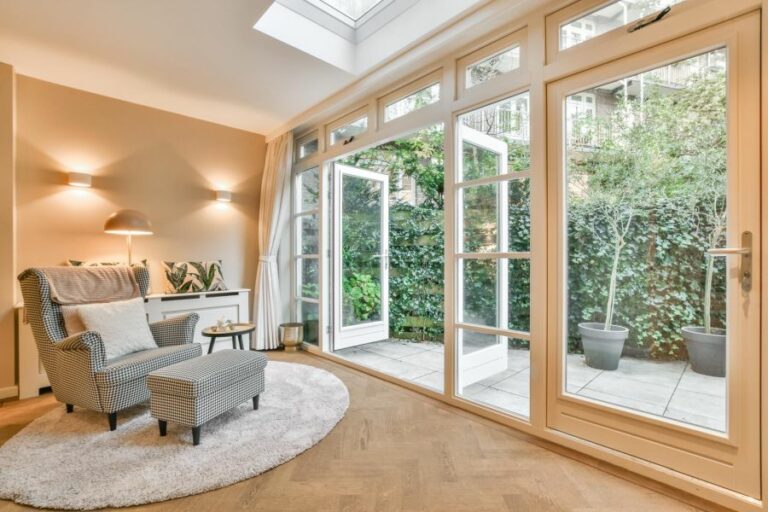How To Brighten Small Rooms With Paint, 25 Things You Should Know
Are you tired of feeling cramped in a small room? Worry no more, as I have the perfect solution. With just a few strokes of paint, not only will we unlock the true potential of your space, but we will also make it incredibly inviting!
How to brighten small rooms with paint:
To brighten small rooms with paint, choose light colors for walls, use satin or semi-gloss finishes, and paint ceilings a lighter shade than walls. Consider adding accents wall in a darker or vibrant shade, utilize reflective paints to maximize natural light, and apply painting techniques, such as vertical stripes or ombre, to create depth and spaciousness.

Discover the transformative power of paint and learn how to make small rooms appear larger and brighter with our expert tips and tricks. Unleash your creativity and turn cramped spaces into beautiful havens.
Read on to unveil the secrets to visual expansion and creating the illusion of space through color!
Contents
- 1 Enhance Tiny Spaces Using Paint Techniques
- 2 Ideal paint colors for enlivening small rooms
- 3 Top paint colors for an expansive small room illusion
- 4 Painting tricks to amplify the size of a small room
- 5 Best paint shades for rooms lacking natural light
Enhance Tiny Spaces Using Paint Techniques
Having a small room doesn’t necessarily mean it has to feel cramped or confined. You can easily bring more light and cheerfulness to any small space with the right choice of paint color and application techniques. Follow these expert tips to achieve that bright, airy feeling in even the most limited living areas.
• Choose Light Colors for Walls
Light-colored walls can help make a room feel more open and bright. Light colors reflect natural and artificial light, filling the space with a warm, inviting ambiance. Stick with a neutral color palette, such as white, beige, or light gray, to create a timeless and versatile look.
Consider soft pastels like light blue, pink, or yellow for a more daring approach.
Keep in mind the color theory when choosing your paint colors. Cool shades, such as blues and greens, can create a more calming atmosphere, while warmer hues, such as reds and oranges, tend to energize a space.
A great resource to help you choose the perfect color for your room is the ColorSnap Visualizer by Sherwin-Williams. This free tool lets you explore various color options and even visualize them in your room by uploading a picture.
• Use Satin or Semi-Gloss Finish
The type of paint finish you choose can also greatly affect the brightness of a small room. I recommend opting for satin or semi-gloss finishes, as they tend to reflect more light than matte finishes.- This reflection helps create the illusion of a larger space while also making it easier to clean and maintain.
However, be aware that a higher sheen finish can highlight any imperfections on your walls. So before applying the paint, make sure to properly prep the surface by filling any holes, sanding rough spots, and using a good-quality primer.
• Paint the Ceiling a Lighter Shade
An often overlooked aspect of brightening a small room is the ceiling. Painting the ceiling a lighter shade than the walls can create a sense of height and make the room feel more spacious. One option is to use a shade that’s one or two tones lighter than your wall color.
Alternatively, a classic white ceiling can complement and enhance any wall color.
• Consider an Accent Wall
While it’s best to keep most walls in a small room light-colored, adding a single accent wall in a slightly darker or more vibrant shade can create depth and visual interest. This technique helps draw the eye to the furthest corner of the room, making the space appear larger.
When choosing an accent wall, consider the room’s lighting and layout. Ideally, the accent wall should be well-lit by natural light or strategically placed light fixtures.
• Maximize Natural Light with Reflective Paints
Some paint manufacturers offer products with reflective qualities designed to maximize the impact of natural light. Such paints contain small, light-reflecting particles that can increase the brightness of a room without changing the color of the walls.
For example, Dulux Light & Space paint line claims to increase the amount of light reflected by up to 40% compared to conventional paint, making small spaces feel larger and more open.
• Employ Painting Techniques to Create Depth
Various painting techniques can be utilized to make your small room feel more spacious. For instance, a simple vertical stripe pattern using two shades of the same color can create an illusion of height.
Similarly, diagonal lines or chevrons can guide the eye around the room, creating a feeling of movement and spaciousness.
Other techniques, such as ombre or color washing, can add depth and character to a small room without overwhelming the space.
• In Conclusion
Brightening a small room with paint is a simple and cost-effective way to create a more welcoming and spacious atmosphere.
You can elevate even the tiniest of spaces into something extraordinary by carefully selecting light colors, using appropriate paint finishes, and employing various painting techniques.
Remember to consider your room’s layout, lighting, and overall aesthetic when choosing your paint colors, and don’t be afraid to experiment with bolder accent walls or unique patterns.
Step | Description |
|---|---|
1 | Choose light colors, as they reflect more light and give the room a brighter feel. |
2 | Consider using paint with a satin or semi-gloss finish, which reflects light better than matte finishes. |
3 | Paint the ceiling a lighter shade than the walls to create the illusion of higher ceilings. |
4 | Consider using a monochromatic color scheme by choosing different shades of the same color to create visual interest without overwhelming the space. |
5 | Add pops of color using accessories and artwork to prevent the space from feeling bland. |
6 | Maximize natural light by keeping window treatments simple and light in color. |
Ideal paint colors for enlivening small rooms
A small room can often feel cramped and uninviting, but the right color scheme can help make it appear larger, more open, and welcoming.
• Light and Neutral Colors
Light and neutral colors are popular choices when trying to make a small room feel more spacious. These colors reflect light, making the space appear brighter and more open.
– White
One of the best colors for enlarging a small room is white. White walls reflect natural and artificial light, making a room appear larger and brighter. This versatile color also works well with any style of decor, from modern minimalist to cozy and warm.
– Off-Whites and Light Grays
Off-whites and light grays offer a bit more visual interest than pure white while still providing a similar effect. These colors create a sense of space and lightness while also adding subtle warmth and depth.
– Soft Beige and Warm Cream
For a cozier atmosphere, consider soft beige or warm cream colors. These hues provide a welcoming warmth to a small room while still reflecting light and creating a sense of spaciousness.
• Cool Colors and Pastel Tones
Cool colors and pastel tones can also work well in small rooms, as they help to create a sense of depth and recede from the viewer, making the room appear larger.
– Light Blue
One of my top recommendations for a small room is light blue. This cool color provides a clean, refreshing feel while also making the room appear more open and airy. For an elegant touch, consider choosing a delicate shade of blue such as powder or sky blue.
– Pale Green
Another excellent color for small spaces is pale green. This cool and calming hue gives a room a fresh, lively feel while helping to create the illusion of more space. Options like mint or sage green work nicely.
– Lavender and Soft Pink
For a more feminine touch, consider using soft shades of lavender or pink in a small room. These colors provide a sense of relaxation and tranquility and can help to make a compact room feel larger.
• Color Coordination and Accents
In addition to choosing the right base colors, thoughtful use of accent colors and coordinated accessories can help to enhance the sense of space in a small room.
– Keep it Simple
Avoid using too many contrasting colors when working with a small room, as this can visually break up the space and make it appear cluttered. Instead, choose a few complementary colors to create a cohesive look.
– Use Dark Colors as Accents
Although lighter colors are generally preferred for small spaces, dark hues can be used effectively as accents. For example, a deep navy blue or rich burgundy can be used to highlight architectural features or furniture, providing depth and interest without overwhelming the space.
– Add Pops of Color with Accessories
Brightly colored accessories, such as pillows, artwork, or decorative objects, can bring energy and personality to a small room without closing it in. Choose a few eye-catching pieces in a coordinating color scheme to create visual interest and draw the eye throughout the space.
• Tips for Maximising the Effect of Color in a Small Room
Here are some additional suggestions to help make the most of your chosen colors in a small room:
– Use Color to Draw Attention Upwards
Painting the ceiling a lighter shade than the walls, or adding a colorful accent along the upper edge of the walls, can help draw the eye upwards and create the illusion of higher ceilings.
– Consider Reflective Finishes
A paint finish with a slight sheen, such as an eggshell, will help to reflect light and make the room appear brighter. Additionally, mirrors or metallic accents in a small room can enhance the light-reflecting effect.
– Choose Furniture and Decor in Similar Colors
By selecting furniture and decor in colors that closely match your walls, you can create a seamless, cohesive look that makes the room appear larger. This technique is often used in Scandinavian interior design and can be seen on Washington State University’s page on Small Space Living.
In conclusion, the right color choices can significantly impact how spacious and inviting a small room appears. By selecting light, neutral colors, cool tones, or pastel hues, and thoughtfully coordinating accents and decor, you can create a welcoming and enjoyable space that feels larger than it actually is.
Top paint colors for an expansive small room illusion
We’ve all encountered small spaces and the challenge that they can present when it comes to decorating. Selecting the right paint color is crucial to create a more open and expansive feel in your small room.
• Light Colors: The Go-To Choice
Light colors are a classic choice when aiming to create the illusion of a larger space. You’ve probably heard that white walls can make a room feel bigger, and there’s a reason for this: lighter shades reflect more light, making the space seem brighter and airier.
Some of the most popular light shades to consider include:
- Soft Whites: Creamy or off-white tones create a warm and inviting atmosphere while still reflecting a good amount of light.
- Cool Grays: This neutral option can add a sophisticated touch to your space while also being versatile enough to match many different colors.
Color Matters is a helpful resource for understanding the relationship between color and space perception.
• The Power of Monochromatic Palettes
To further enhance the illusion of a larger room, a monochromatic color scheme is often recommended. This means using various shades of the same color throughout the room, creating a harmonious and cohesive look.
A monochromatic palette allows the eye to move more smoothly through the space, which can give the feeling of a more open area.
For example, consider decorating with darker gray accents and furniture if you choose a soft gray for your walls. This approach can create a sense of depth and spaciousness in your small room.
• Consider Undertones and Lighting
While lighter colors are generally the best option for small spaces, the specific undertones of the colors you choose play a significant role in the room’s perceived size.
Cool undertones such as blue, green, or purple can make a room feel more open and spacious, while warmer undertones, like red, orange, or yellow, might create a cozy atmosphere.
Evaluate the natural and artificial lighting of the space before selecting your color. Rooms with limited light may benefit from paint with a cool undertone, as it can make the space feel less cramped.
However, a warmer undertone might create a more welcoming feeling if your small room has ample natural light.
• Contrasting Elements: Use Wisely
Incorporating contrasting colors in a small room can be an effective way to create the illusion of more space, but it can also be risky. Contrast contrasts can make a room feel cluttered or overwhelming if not done thoughtfully.
One effective way to use contrasting colors is to choose a subtle and neutral contrasting color for baseboards, window trim, or molding. This can create a visual separation between the walls and architectural elements, making the space appear larger.
• Mirrored or Glossy Finishes
Another way to amplify the feeling of a more spacious room is to use mirrored or glossy finishes on some surfaces.
You might not want to paint the entire room with a high-gloss paint because it can be overwhelming; however, adding glossy finishes to certain elements, such as doors or trim, can reflect more light into the space, making the room seem larger.
• The Personal Touch
Ultimately, the color you choose for your small room should make the space appear larger and reflect your personal taste and style. Remember to consider factors such as undertones, lighting, and the room’s overall design when selecting the perfect paint color.
By selecting the right color and design elements for your small space, you can transform it from cramped and crowded to open, inviting, and visually larger. Happy painting!
Color | Effect |
|---|---|
Light colors (white, light gray, etc.) | These colors reflect more light and make a room feel more open and spacious, creating the illusion of a bigger space. |
Painting tricks to amplify the size of a small room
A small room can sometimes feel cramped and uncomfortable, but with the right paint colors and techniques, you can create an illusion of a bigger space.
• Choose Light and Cool Colors
Opting for light and cool colors can help make a small room appear bigger by reflecting more light and creating a sense of openness. Colors such as white, light gray, and soft blue or green pastels make excellent walls, ceilings, and trim choices.
According to a study by Purdue University, lighter shades and cool colors have a receding effect, which means they make walls and other surfaces seem farther away than they actually are.
– Contrast Colors Wisely
Avoid using strong contrasting colors between walls, trim, and other architectural elements to enhance the feeling of spaciousness. Instead, choose a monochromatic color scheme by varying the saturation and tones of a single base color to create a sense of unity, flow, and openness in the room.
• Opt for a Matte or Eggshell Finish
The finish of your paint plays a crucial role in creating the optical illusion of a bigger room. While glossy paints are known for reflecting more light, their shiny surface can highlight imperfections and draw attention to awkward angles, making the space look small and confined.
I recommend using a matte or eggshell finish as they reflect light more evenly, providing a subtle glow that makes the room appear more spacious.
– Ceiling Paint Tips
To create the illusion of a higher ceiling, paint it in a lighter shade than the walls. This visual trick will draw the eye upwards and make the room feel taller. Alternatively, consider adding thin horizontal stripes to the walls to make the space appear wider.
• Properly Prepare the Room
Before you start painting, preparing the room adequately to achieve professional-looking results is essential. Move as much furniture as possible out of the room or cover it with protective drop cloths.
Clean the walls thoroughly with a mild detergent solution to remove dirt, grease, or dust that may have accumulated; this step is essential to ensure the paint adheres correctly and dries evenly.
– Use Quality Paint Brushes and Rollers
Investing in good quality paint brushes and roller covers will make the painting process easier and lead to a smoother and more professional-looking finish.
A quality paintbrush will help you achieve crisp, clean lines and edges, while a high-quality roller cover will provide even coverage and reduce the likelihood of streaks and roller marks.
• Apply Open-Ended Painting Techniques
Open-ended painting techniques can help create an optical illusion that the walls of a small room extend beyond their actual boundaries. For example, consider using a light and airy color on three walls and painting the remaining wall, preferably the one facing direct sunlight- with a slightly darker shade.
This technique, known as an accent wall, creates a perception of depth, making the room appear larger than it is.
– Soft Transitions between Colors
If you want to introduce multiple colors or patterns in a small room, ensure that the transitions between them are smooth and subtle to avoid visually breaking up space. Blending or fading the colors on the boundary between them is a great way to achieve this effect.
• Add Visual Interest with Decorative Painting Techniques
Incorporating decorative painting techniques such as stenciling or faux finishes can add depth and visual interest to the room without overwhelming the space. These techniques allow you to introduce patterns and textures while maintaining a cohesive color scheme that keeps the room feeling open and spacious.
• Final Thoughts
Painting a small room to make it look bigger may seem like a daunting task, but by choosing the right colors, finishes, and painting techniques, you can create an optical illusion of a more spacious and open room.
Remember to keep the color palette light and cool, use matte or eggshell paint finishes, and employ open-ended painting techniques. With these tips, you’ll soon transform your small space into a room that feels more open and inviting.
Step | Instructions |
|---|---|
1 | Choose light colors, as they reflect more light and make spaces feel bigger. |
2 | Use monochromatic color schemes to create a cohesive look and reduce visual clutter. |
3 | Paint the ceiling a lighter shade than the walls to create the illusion of height. |
4 | Maximize natural light by choosing window treatments that allow light to flow into the room. |
5 | Use a glossy finish for the paint, as it reflects light better than matte finishes. |
6 | Paint vertical or horizontal stripes on the walls to create the illusion of width or height. |
7 | Use mirrors and other reflective surfaces to enhance the visual space in the room. |
8 | Keep the decor and furniture minimal to avoid clutter and make the room appear more spacious. |
Best paint shades for rooms lacking natural light
Let’s face it: not all rooms are blessed with an abundance of sunlight. However, that doesn’t mean you can’t make the space feel airy, fresh, and inviting. Choosing the right paint color is essential when working in a room with low natural light.
• Colors that Brighten Up Dark Spaces
When it comes to selecting paint colors for poorly-lit rooms, the general rule of thumb is to pick lighter shades. This will help reflect the available light and create a brighter, more spacious atmosphere. Here are some top recommendations from professionals:
1. Soft Whites and Off-Whites
Soft whites are ideal for rooms with minimal natural light. These hues promote a clean and open feel. For example, opt for shades such as Benjamin Moore’s Simply White or Sherwin Williams’ Alabaster.
2. Pale Grays
Pale grays can also be a great option for dark rooms. These tones provide a neutral backdrop that can be dressed up with colorful decor. Consider shades like Farrow & Ball’s Cornforth White or Behr’s Light French Gray.
3. Soft Blues and Greens
These colors evoke a sense of serenity and can create an inviting atmosphere in a dimly lit space. Opt for muted shades such as Sherwin Williams’ Sea Salt or Benjamin Moore’s Wythe Blue.
4. Pale Yellows and Creams
A room painted in a light-yellow shade can add warmth and create a cozy feel. Good choices include Valspar’s Buttercream and Farrow & Ball’s White Tie.
• Colors to Avoid in Low-Light Spaces
Specific color categories might not work well in rooms with little sunlight. These include:
- Dark colors: Deep hues like navy or burgundy will make a dimly-lit space feel even darker.
- Intense colors: Bright, saturated shades might appear muddy in spaces with low natural light.
• Tips for Maximizing Light in Dark Rooms
Aside from selecting the right paint color, other design elements can be implemented to enhance the existing light in a space. Here are a few professional recommendations:
1. Reflection and Mirrors
Incorporating mirrors and other reflective surfaces can help by bouncing light around the room. Position large mirrors strategically so they reflect the available light from windows or light fixtures.
2. Clever Lighting Design
Having a combination of overhead lights, floor lamps, and table lamps enables you to control the illumination levels in the space. Make sure to use warm white bulbs since they create a cozy atmosphere.
3. Light-Colored Furnishings and Flooring
Aside from the walls, choose light-colored furniture, window treatments, and flooring materials. This approach will help create a cohesive, bright look throughout the room. For example, opt for cream-colored sofas, whitewashed wood flooring, or light grey area rugs.
4. Opt for Minimal Window Treatments
Allow the available natural light to flow unobstructed by avoiding heavy, dark drapes. Instead, consider sheer, light-colored curtains or simple blinds.
In conclusion, the key to choosing a paint color for rooms with low natural light is to prioritize light, soft shades. These hues will help reflect the existing light and create a brighter, welcoming atmosphere.
Additionally, implementing smart lighting design and reflective surfaces can further enhance the ambiance of your space. Following these expert tips can transform even the darkest room into an inviting sanctuary.
For further guidance on color choices and interior design, consider consulting resources such as the American Society of Interior Designers.







